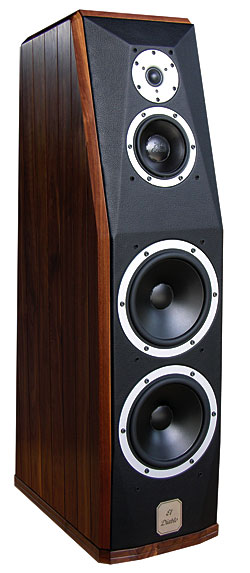| Columns Retired Columns & Blogs |
Peak Consult El Diablo loudspeaker
The devil's in the details, so here's one detail you should know going in: The El Diablo, a deceptively modest-looking, casket-like, compact, three-way loudspeaker from Danish firm Peak Consult, will cost you a penny less than $65,000/pair. Why? Yes, the dollar's continued slide has alarmingly driven up the price of imported audio gear, but even so...
 The Details
The Details
Though it's only 44.5" tall, 11.8" wide, and 21.5" deep, the Diablo weighs a hefty 188 lbs. Clearly, a great deal of something has been packed into its relatively small cabinet, and it's not lead.
The hand-built enclosure is a glued sandwich of various thicknesses (1.5–3") of high-density fiberboard (HDF), with specially designed resonance suppressors at key spots. Encasing that is a 1"-thick skin of solid, hand-selected Italian walnut. Despite the speaker's outwardly rectangular shape, no two of its interior walls are parallel, to avoid standing waves. This is one well-put-together cabinet that I feel absolutely confident will pass John Atkinson's accelerometer test with ease.
The front baffle's slant and back-tilt are said to align both the phase and the arrival times of the outputs of the tweeter, midrange, and woofers. Though often promised by speaker makers, this is rarely delivered—as anyone who pays attention to JA's "Measurements" sections knows.
Adding to the Diablo's weight are its top-shelf drivers. The 1" tweeter, made by Scan-Speak (another Danish company), is a low-compression design that does without ferrofluid cooling or a phase plug. It has an neodymium motor, and its nonresonant backwave chamber and machined faceplate are both made of aluminum.
The 5" midrange unit and two 9" woofers (which feature "huge" magnets, per Peak Consult) are custom-built to the designer's specifications by AudioTechnology, yet another Danish company, which was cofounded by Ejvind Skaaning (and his son), who also founded Vifa/Scan-Speak and Dynaudio. AT drivers are used by Rockport Technologies and Sonus Faber, among other brands that don't blush at selling expensive loudspeakers.
The Diablo's second-order crossovers, set at 200Hz and 4.8kHz, are hardwired with silver solder and use cost-no-object electrical components chosen for their sonic characteristics. The network is sealed at the cabinet bottom to eliminate microphonics and to shield it from electrical and magnetic radiation. Internal wiring is from Stereovox, an American company owned by Peak Consult importer Signals SuperFi. The biwire terminals comprise two pairs of WBT Platinum Signature binding posts.
Designer Per Kristoffersen claims the Diablo is easy to drive, with a gentle, low-current-drawing phase angle, a sensitivity of 94dB/W/m, and a load of close to 7 ohms across its entire claimed in-room response of 20Hz–45kHz, –3dB.
Clearly, its build and parts qualities are high, but to really appreciate the Diablo's workmanship and exquisite finish—and its price—you need to see it close up and run your hands across the stunning woodwork. Photos just don't do it justice. With its leather-clad front and rear panels, its cravat-shaped mid/tweeter grille cover (which I left off for my auditioning), and its angled front baffle, the Diablo shares some of its appearance with speakers from other brands. But while it lacks the visual allure of, say, the Sonus Faber Stradivari Homage, and some other dramatically sculpted speakers, not everyone, especially of the wifely variety—I'm a realist, not a sexist—is looking to make a loudspeaker fashion statement in the living room. The Diablo can blend in like the finely finished piece of furniture that it is, and its size and footprint would seem to make it an ideal candidate for the city sophisticate's drawing room.
Setup
Positioning the Diablos was easy. They sounded best in my room where almost every other pair of speakers has: where RPG's computer program said they would, based on the room's dimensions and the physics of wave propagation. And I sat where I always do: where the program tells me to, about 11' from the front wall and 8' from the speakers.
RPG's program takes into account the height, size, and location (front, side, or rear) of a speaker's woofer(s). While variations in these factors will affect the results to a small degree, there's been a remarkable consistency of speaker positions throughout the years I've used the program to review speakers in this room. Almost all of them, El Diablos included, end up about 9' apart, a bit more than 2' from the front wall, and toed-in, with the corners of their rear baffles about 3' from the sidewalls. The Diablos sounded best with their tweeters firing directly on axis.
Listening
The understated and meticulous sensibility informing the Diablo's appearance has also been applied to its sound. And like my first look, my first listen to them, with the importer in the room, was definitely underwhelming. Going directly from the Wilson Audio MAXX Series 2s to the Diablos was like going from fluorescent bulbs to candles—or, to be less subject to misinterpretation, like stepping out of a Ferrari and into a high-performance Bentley coupe. It took me some time to appreciate what the Diablo could do. While definitely full of surprises, it drew me in rather than bowled me over—but it was never "polite" or "reserved."
- Log in or register to post comments




































